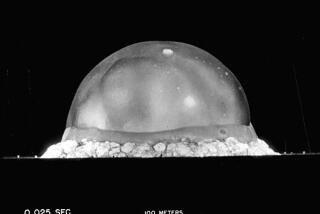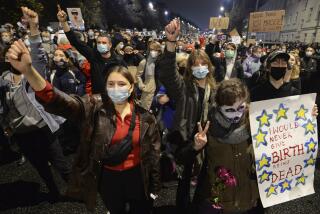European Nations at the Brink of the Greatest Boom of the Century : Economy: Phenomenal growth rates are possible if the sovereign states of East and West integrate. Short of that, we face a new Dark Ages.
- Share via
ROME — How is it that, in the span of a mere decade, Europe has made the transition from Eurosclerosis to Europhoria? I believe Europe has entered the ascendant phase of a new Kondratieff Cycle--the more or less 50-year generational cycle of change in which technological and political innovation overcomes stagnation and generates a new economic boom.
The new momentum began with a decision among the key European powers to integrate by 1992. In effect, integration was the political response to the necessity of moving from an industrial to a post-industrial society. Already tied together by television, videos, fax machines, rapid trains and air travel, Europe’s well-educated, largely white-collar consumers required more than the establishment of a vast internal market for merchandising manufactured goods. It required a real, unified economic and cultural space.
This idea of 1992 produced exactly the same psychological effect in the minds of the Japanese, Americans and Eastern Europeans. Japan and America began to fear a prosperous Fortress Europe from which they might be shut out. Eastern Europeans, especially the young, saw a model of prosperity to which they wanted to belong. More than anything else, this triggered the mass migrations and the evolution toward reform in Eastern Europe that (thanks to Mikhail S. Gorbachev’s restraint) turned into the Revolution of 1989.
The new Europhoria is well founded. Europe will experience in the 1990s the most important economic boom of the century for three reasons:
The extension of the market economy to Eastern Europe will provide new impulse to Western European businesses, from revamping phone systems to the installation of pollution-control equipment.
New consumers, 140 million of them, from the East will, sooner or later, generate massive demand for such items as cars, cameras, personal computers, stereos, compact-disc players and washing machines.
Disarmament is expected to free at least 0.8% of Western Europe’s total gross national product for new investment in the expanding market.
Taking these factors into account, the average growth rate in Europe during the 1990s is likely to be 5%--twice that of the projected U.S. rate of 2.5%. The combined GNP of the 18 countries of Western Europe, with their 400 million people, could be as large as $6 trillion by the mid-1990s--that is, 1.5 times larger than the U.S. economy and two to three times larger than the Japanese economy. As long as the world trade system does not splinter into blocs over these projected spoils, the United States, Japan and Europe together could produce the greatest economic boom in history.
All this points to Europe recovering its role as the core of the world economy. The next 10 years will make evident Japan’s weakness: A population of 123 million is relatively small and politically marginal. Obviously, if Japan and the United States could move toward some form of integration, this assessment would change.
While Europe is not yet integrated, the political momentum to do so has never been stronger. To shape this momentum, a medium-term scaffold of integration must be built to counterbalance the weight of a united Germany. Practically speaking, the integration of East and West means the integration of Central Europe. Because West Germany and Italy are the two countries of the West that border the East, along with neutral Austria, integration in these places will occur more rapidly. Apart from the security issue, German integration will be a relatively easy matter. But for us, nothing is unified. Our neighboring countries not only have different economic and social systems, but their people speak different languages and have varying cultural backgrounds. For this reason, Italy, Czechoslovakia, Hungary, Yugoslavia and Austria have organized a regional association. Together, these countries will contribute to a more even balance of power in the future Europe.
Above all, Europe--whether speaking of the current group or future 33 states (combined East and West)--must remain open. A Fortress Europe engaged in competitive economic warfare with a renewed Japanese Co-Prosperity Sphere would destroy all that the postwar order has built. It would be a terrible mistake to drift in that direction.
For the moment, that is why the Helsinki Conference--or Conference on European Security and Cooperation--is the most important political body for Europe. I strongly favor finding a way to end Japan’s political isolation from Europe. Japan, excluded by the North Atlantic Treaty Organization 41 years ago, should be brought into the Helsinki Conference. Everyone would benefit from this closer political association.
The model to which the Eastern Europeans aspire is not that of Japan or the United States, but of Western Europe. That model embraces democracy, pluralism, a market economy and the welfare state. Despite its recent setback in the East German elections, social democracy will undoubtedly have a broad, even dominant, appeal in an integrated Europe.
Before the end of 1990, a formalized all-European Union of Social Democratic Parties will be organized, including former European Communist parties from Hungary to Italy, and perhaps in a not-too-distant day, the Soviet Union as well. Whether in power or opposition, such a united European left will guarantee the endurance of Europe’s singular legacy--the welfare state.
The institutional form of European integration will itself be subject to innovation. The old 18th- and 19th-Century democratic mechanisms of integration, such as federation or confederation, do not correspond to reality on the eve of the 21st Century. Democracy will have to be reinvented.
Inevitably, in a global marketplace faced with ecological threats as well as problems of economic coordination and North-South inequality, political power must be transferred from sovereign nations to supranational institutions. The resultant democratic deficit will have to be offset by a redistribution of power to autonomous regions, cities and citizens. In the 21st Century, neither level--global nor local--can work without mutual accountability. All that is certain for now is the obsolescence of the nation-state.
In psychological terms, 1989 was like 1945. It marked the end of a period of war and division. Unfortunately, the way we set about reconstruction in 1946-47 created the basis for the Cold War.
Thus, the crucial issue of 1990 is how to end East-West conflict in a way that doesn’t create the basis for a new world war--between North and South. If conflict, whether in conventional terms or terrorist terms, proliferates, the promise of boom and prosperity will collapse.
Above all, we must avoid the schism of one interdependent world with two civilizations. Environmental issues, including poverty and development, along with religious disputes, pose the greatest risk to the promise of integration. The Salman Rushdie affair offers a sobering preview of the deadly conflict between the modern promise of integration and the counterrevolt against interdependence.
The realities of global interdependence are a fait accompli. An integrative response to this reality means we are capable of managing the complexity of the 21st Century by finding the ground of common interest. The ecological consciousness, disarmament and the open global market are examples of the integrative tendency. Attempts at disintegration, or fragmentation out of fear and uncertainty, are negative reactions to interdependence, manifest as protectionism, ethnic nationalism and religious fundamentalism.
The future of humankind lies in the success of integration. That is why, for me, Europe is the test for all humanity. Europe is at the nexus of the most important challenges of integration: the integration of the sovereign nations of the West, on one hand, and the East-West integration on the other.
If we do not realize during the next 20 years the optimism of our will, a new Dark Ages of nationalism, fragmentation, racism and violence may well be the price of failure.
THE VENETIAN: Italian Foreign Minister Gianni De Michelis dodges brickbats at home for his Venice world’s fair promotion. M2.
More to Read
Sign up for Essential California
The most important California stories and recommendations in your inbox every morning.
You may occasionally receive promotional content from the Los Angeles Times.













